CASTELSEPRIO - TORBA
Complex of S.Giovanni
The religious COMPLEX OF SAN GIOVANNI EVANGELISTA, consisting of a Basilica with a Baptistery and a cemetery, and constitutes the most important monument built in the castrum between the Late Antique and the Early Middle Ages period.

S. Giovanni complex. Plan and axonometric reconstruction of the Longobar building
BASILICA OF SAN GIOVANNI
The Longobard Basilica of San Giovanni stands upon the remains of a previous place of worship with a rectangular chamber and polygonal apse with three entrances from the side of the façade; on the north-eastern side of this building there was once an octagonal apsed Baptistery.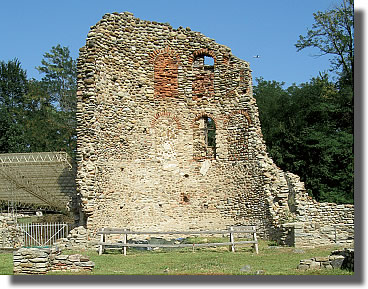
Apse of S. Giovanni
In the 7th century, during the Longobard era, the complex was completely reconstructed, the rectangular chamber was divided into three naves while the apse was raised and took the shape of a a hemicycle.
The northern entrance from the façade was blocked to allow the burial of a knight who, according to the characteristic Longobard funeral ritual, was buried with his coat of arms sometime around the second third of the 7th century.
The Baptistery, which remains unaltered in form, was probably linked to a corridor on the north-West corner of the nave at the apse.
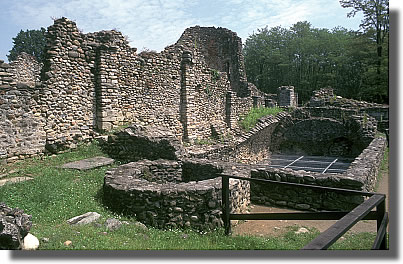
S. Giovanni complex. Late roman cistern
The Basilica walls consist of regular courses of pebbles and smalls stones mixed with dense lime mortar; during this phase the apsidal area and the nave were probably separated by a presbyterial barrier, to which belonged a marble pluteus from the 6th-7th century, now in the museum of Gallarate.
The slab bears an engraving representing four arches on columns each framing a simple cross. The small column with capital bearing decorations imitating the Corinthian style – from the Late Longobard period (8th century) – belonged to a pergula or ciborium, which may have been part of a sumptuous liturgical church furnishing apparel.
Several sections of plaster that are still visible in the interior wall of the Basilica may also be from the Early Middle Ages. Only one stone plaque remains today as a clue of the original magnificence of the opus sectile marble encrustations, including hexagonal and triangular elements, the same type as those found in the Baptistery and in the Church of Santa Maria in the burg of the castrum.
Along the southern side of the Basilica is a large rectangular cistern dating back to Late roman times. This was probably built to collect and use water from the roof of the church. The structure preserves the attachment points of the barrel vault and the flooring in waterproof cocciopesto mortar.
Over the long period during which it was in use, the cistern underwent numerous renovations and consolidation works and the emerging wall today is very similar to those of the nearby basilica. On the western side the structure is connected to a well with “mushroom” shaped opening which was already walled up at the time of its discovery. From the rubble that filled a small well, among other materials found, there was an interesting gold Byzantine coin dated from the 6th century, therefore to the period of Longobard occupation.
CHURCH OF SANTA MARIA
The original phase of the church dedicated to Santa Maria is also attributed to the Early Middle Ages, erected as part of the same Monastery complex opposite the Tower. Excavations have demonstrated the chronological sequence of construction work over four main phases, with successive reconstructions due to the sinking of the southern perimeter wall, imprudently founded on an unstable mass of pudding-stone.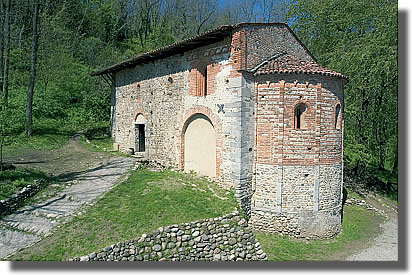
Church of S. Maria. Apse and southern side
The current building with a single chamber and truss roof, built with river cobblestones and despoiled stone, is mainly attributed to the 11th century, while the apse section, made from large pebbles and bricks and decorated with hanging arches, which shows a more mature architectural approach, is fully romanesque and attributable to the 13th century.
A number of scholars believe that the first early mediaeval church had a single chamber, equipped with an ambulatory crypt, with access via two side stairways, partly dug out from the rock, partly built from recycled material.
Excavations have uncovered the crypt of this first structure, together with the stairwells and a number of
fragments of 8th century frescoes. Other painted fragments, attributable to the same period of the Early Middle Ages were found in the archaeological digs carried out there and currently being studied.

Church of S. Maria. Eastern and Southern architectonical surveys
The remains of frescoes that are still present in the inner walls of the church testify that all construction phases were matched by a new series of paintings: remains of scenes painted in the 11th century on the long walls to the south and to the north still remain today and were probably set out in two tiers (other fragments from the same period were found during excavations).
In the apse there are fragments of a painting from the 13th century, perhaps depicting a martyr with a palm branch.
Fragments of painted decorations have also been found on the inner wall of the bell tower, which was reconstructed in the 9th century from an existing tower that was probably in the more ancient boundary wall. Among the remains of frescoes there is a particularly interesting fragment which can be traced to the 11th century, depicting a male figure accompanied by the writing “K(a)im”, and identified as Saint Joakim or perhaps Cain.
THE BAPTISTERY
The Baptistery, has an hexagonal floor plan with a south-West little apse, and is similar to the ones in Grado and Cividale; the original construction phase dates back to the 5th-6th century.
The building includes a baptismal font for total immersion, also covered in marble, which does not stand in the center of the building.
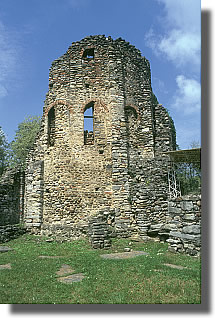
The floor is executed in opus sectile, including marble encrustations of hexagonal and triangular geometrical forms cut out of white marble from Musso and black marble from Varenna; the wall module of the elements composing the main body of the church varies as to size and texture from the one employed in the apse of the same Baptistery.
The original faux marble decoration on the walls was replaced during the Longobard era by a ornamental geometric pattern painted on the rose-coloured base of the plaster. During the Longobard era, the common christian practice of burying the dead in and around churches is attested by numerous earth burials dating from the 7th-8th century, and which also cover the area to the east and south of the worship complex.
BURIAL AREAS
Two tombs, one found in the apse and the other in the presbytery area of the Basilica of San Giovanni, belonged to personalities from the local aristocracy or the clergy. Other burials of high-ranking personages have been found in the inner area and near the liturgical annex of the basilica, dug out of an existing tower on the south-eastern side.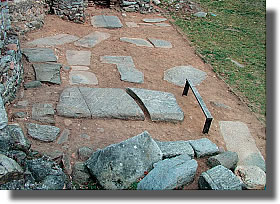 S.Giovanni. Monolithic slabs of a tomb from cemetery near the Church |
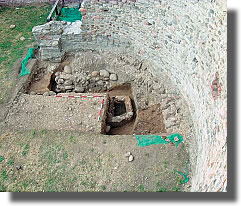 A tomb and the remains of original apse |
From this cemetery area, explored on several occasions, come a number of horse bone remains; the custom of burying a knight with his horse is seen in other Longobard necropolises, including those of San Mauro in Cividale del Friuli and in Nocera Umbra.
The cemetery area and the burials inside the building point to the funerary use of the Church of Santa Maria during the centuries, its earliest phase probably dating back to the middle of the 8th century, or to a date slightly later than this. Recent excavations (summer of 2009) have brought to light the burial located in the outer perimeter wall on the north side. On account of the style of the characters written on the outer monolithic covering, it appears to be similar to the style of writing found on certain tombs found in the castrum area, which date to a time between the 6th and 8th century A.D.
The burial at present is judged ad possibly corresponding to the Early Medieval phase of the building. The data from the excavation is still being studied.
Among the burials found in the Baptistery area – some of which are plastered according to a common practice of the Early Middle Ages – there are a number of earth burials, with monolithic coverings decorated with spear-shaped crosses sculpted in low-relief, belonging to persons of high lineage, aristocracy or prelates. This type of covering is widespread in Italy and beyond the Alps, particularly in towns, with or without castles, which had a settlement tradition in the Late Roman era and which were integrated at an early date into the ecclesiastic hierarchy (Lake Garda area, or Vaison la Romaine in Provence).
HOUSING SYSTEM
Only a few areas of the residential areas within the castrum sector that have been explored and show definite phases from the 5th-6th century to the latter part of the Early Middle Ages.
Civil construction during the Longobard period was concentrated in an area of the old town, buttressed against the south- Western walls; the houses, lined up along cobbled streets leading to the central religious complex, have different dimensions and layout; all, however, have at least the foundations made of stone. Some have only one room with a stone base for the central support column for the roof; others have more than one room, with annexed facilities.
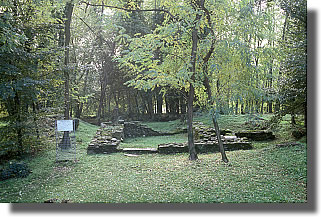 Remains of Early Middle Ages houses |
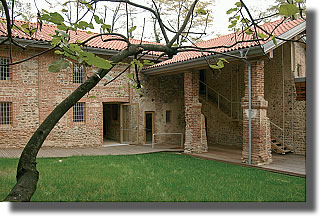 Farmhouse of s. Giovanni, housing the Antiquarium |
Houses from the same Longobard period are nevertheless distributed in the area north of the great basilica and probably also in the eastern area of the castrum. The varying thickness of the dwellings which have been explored suggest that some had stonemasonry walls, or, in other cases, walls made of wood and other perishable materials, such as cane and clay of the type that is also present in Brescia and in other areas of early Mediaeval Italy. The numerous remains of roman-tradition roof tiles are proof of the quality of the settlement’s housing system.
Loom weights for weaving and moulds, elements used to print and to regulate the low of molten metal, crucibles employed to work iron, bronze and copper, attest to the presence of production activities, as well as objects made out of unfinished elements. The recovery of a fragment of a type of stone cooking utensil called pietra ollare indicates that possibly these containers were produced in a place not too far away.
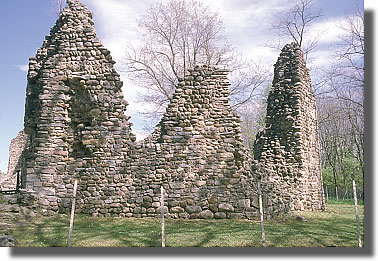
Worship building dedicated to St.Paul
In addition to the early mediaeval monuments, it is also important to highlight the presence of a religious building dedicated to Saint Paul, which today lies in ruins, and which is mentioned by 11th century sources, and may possibly date to the 12th century. Identified as a church by some researchers and by others as a baptistery, it presents a hexagonal plan, with ashlar stone elevation with mainly regular courses. Its apse is scanned by pilasters, and ornamented by blind arches which flank splayed windows.
It is still to be ascertained whether the building was remodelled in ancient times the central area is surrounded by an ambulatory, on which stands a loggia supported by six central columns, thus forming the upper floor which was accessed probably via a stone stairway dug out of the northern wall. According to the descriptions made of the pastoral visits which took place from the 16th century onwards, it seems that the building was originally equipped with a small apse over the altar which was decorated with frescoes.

Entrance of the farmhouse, hosting the Antiquarium
The farmhouse of San Giovanni, a small building of the 14th century, was built over the remains of a Longobard building, of which few elements have been identified. this was initially built as a monastery of the order of the Umiliati, later housed Franciscan friars, and was decorated with beautiful frescoes in the 16th century.
The building was reduced to farmhouse status in the 18th century and today it hosts the Antiquarium of the Archaeological park, where the most significant artefacts of local history are held. They have been selected among the many successive campaigns affecting the castrum from the mid-19th century onwards.


